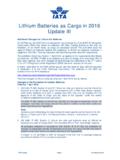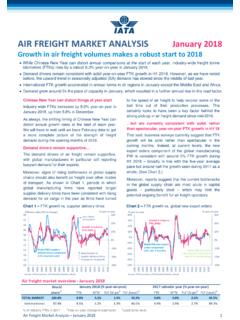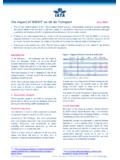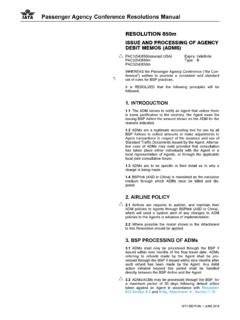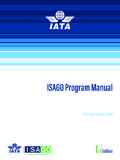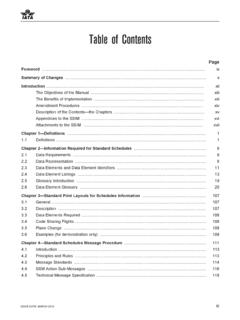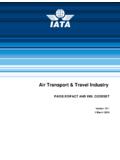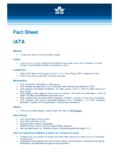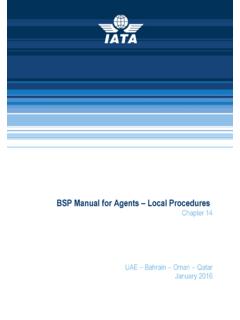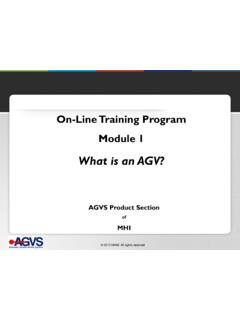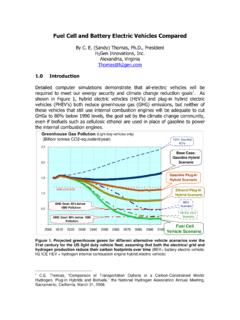Transcription of Battery-Powered Wheelchair and Mobility Aid Guidance …
1 1 Battery-Powered Wheelchair and Mobility Aid Guidance Document 28 January 2022 Battery-Powered Wheelchair and Mobility Aid Guidance Document Transport of Battery-Powered Wheelchair and Mobility Aid Carried by Passengers Revised for the 2022 Regulations Introduction This document is based on the provisions set out in the 2021 2022 Edition of the ICAO Technical Instructions for the Safe Transport of Dangerous Goods by Air (Technical Instructions) and the 63rd Edition of the IATA Dangerous Goods Regulations (DGR). Information on the DGR can be found here: The batteries that power wheelchairs and Mobility aids are considered dangerous goods when carried by air. These and some other dangerous goods that are permitted for carriage by passengers can be transported safely by air provided certain safety requirements are met. The requirements are detailed in the IATA Dangerous Goods Regulations, which are based on the ICAO Technical Instructions.
2 Training is an essential element in maintaining a safe regulatory regime. It is mandatory for all individuals involved in the preparation or transport of dangerous goods, including battery powered wheelchairs and Mobility aids, to be trained to carry out their responsibilities. Depending on the job-function, this will require familiarisation training or more detailed training on the specific requirements in the Regulations. It is important to remember that dangerous goods are very unlikely to cause a problem when they are prepared and handled in compliance with the IATA Dangerous Goods Regulations. Passengers whose Mobility is restricted by either a disability, their health or age, or a temporary Mobility problem ( broken leg) may travel with a Battery-Powered Mobility aid with the operator s approval. Proper pre-notification by the user helps ensure all parties involved in the transport chain to: know what device(s) and battery type(s) are being transported; understand how to properly load and handle them; and follow the relevant emergency response procedure(s) should an incident or accident occur during flight or on the ground.
3 The pilot-in-command must be informed of the location of the Mobility aid with installed batteries , removed batteries and spare batteries , to best deal with any emergencies that they may occur. 2 Battery-Powered Wheelchair and Mobility Aid Guidance Document 28 January 2022 Inadvertent operation of Battery-Powered Mobility aids can cause friction or electrical load which could lead to a fire. If the Mobility aid is loaded in the aircraft with the battery(ies) installed, the electrical circuits must be isolated by following the manufacturer s instructions. To avoid delays during loading, it is important that these instructions and the additional information detailed in the operator approval section of this Guidance document are provided in advance. The purpose of this document is to provide Guidance for complying with the provisions applicable to the transport by air of Battery-Powered wheelchairs and other Mobility aids when carried by passengers as set out in the DGR.
4 Specifically, the document provides information on: Definitions; Limitations and Classification; Operator Approval; Training; Handling; and Frequently Asked Questions. Definitions Battery manager. An electronic device incorporated in the battery circuit to protect the battery and/or cells from events such as over-charge, over-discharge, over-current, over-temperature and cell imbalance. Note: The battery management function may be integrated into the battery or distributed over the control and drive system. Disabled person or person with reduced Mobility . Any person whose Mobility when using transport is reduced due to any physical disability (sensory or locomotor, permanent or temporary), intellectual disability or impairment, or any other cause of disability, or age, and whose situation needs appropriate attention and the adaptation to his or her particular needs of the service made available to all passengers.
5 Ref. Regulation (EC) No 1107/2006, Article 2 lithium -ion batteries (sometimes abbreviated Li-ion batteries ) are a secondary (rechargeable) battery where the lithium is only present in an ionic form in the electrolyte. Also included within the category of lithium -ion batteries are lithium polymer batteries . lithium -ion batteries are generally used to power devices such as mobile telephones, laptop computers, tablets, power tools and e-bikes. Figure 1 Examples of lithium Ion batteries Note: The watt-hour (Wh) rating is a measure by which lithium ion batteries are regulated. lithium ion batteries are required to be marked with the Watt-hour (Wh) rating. 3 Battery-Powered Wheelchair and Mobility Aid Guidance Document 28 January 2022 The Watt-hour rating of a lithium ion battery can also be calculated from the battery s nominal voltage (V) and capacity in ampere-hours (Ah): Ah x V = Wh If only the milliampere-hours (mAh) are marked on the battery, then divide that number by 1000 to get ampere-hours (Ah) ( 4400 mAh / 1000 = Ah).
6 If you are unsure of the Watt-hour rating of your lithium ion battery, refer to the device User Manual or contact the manufacturer. Non-spillable wet batteries . Have an absorbed electrolyte (absorbed glass mat (AGM), gel battery, gel cell, sealed lead-acid (SLS), dry and dry cell) and do not leak any electrolyte or liquid even if the battery case is ruptured or cracked. The batteries must be capable of passing certain vibration and pressure differential tests. Figure 2 Examples of Non-Spillable Wet batteries Note: For the purpose of this Guidance document, this definition also includes batteries which comply with IATA DGR Special Provision A123 or A199. Examples of such batteries are: alkali-manganese, zinc-carbon, nickel-cadmium and nickel-metal hydride batteries . Operator. A person, organisation or enterprise engaged in or offering to engage in an aircraft operation. Spillable wet batteries .
7 Have a number of openings on top where a liquid electrolyte (corrosive) is poured in to maintain the chemical reactions required to generate electrical energy. Figure 3 Example of Spillable Wet Battery Tour operator. An organiser or retailer of package tours and tourism services for sale either directly to travellers or through intermediaries. WCBD. Wheelchair ( Mobility aid) powered by a non-spillable battery, nickel-metal hydride battery or a dry battery. 4 Battery-Powered Wheelchair and Mobility Aid Guidance Document 28 January 2022 WCBW. Wheelchair ( Mobility aid) powered by a wet cell (spillable) battery. WCLB. Wheelchair ( Mobility aid) powered by a lithium ion battery. Wheelchair system. The electrical and electronic traction control system for a Wheelchair including the battery, its manager, the motor speed controller, the user interface and all wiring and safety devices. Limitations and Classification (DGR ) All Battery-Powered wheelchairs or Mobility aids must be prepared to prevent unintentional activation during transport and the battery terminals must be protected from short circuits.
8 The battery can either be securely attached to the device with the electrical circuits being isolated following the manufacturer s instructions or removed following the manufacturer s instructions if the device is specifically designed to allow it to be removed. Battery-Powered wheelchairs or Mobility aids for use by passengers are classified in three main categories based on the battery type that powers the device: Wheelchairs / Mobility aids with non-spillable wet batteries , nickel-metal hydride batteries or dry batteries (DGR ); Wheelchairs / Mobility aids with spillable batteries (DGR ); and Wheelchairs / Mobility aids with lithium batteries (DGR ). Each category has its unique requirements and they must be strictly followed to ensure safe transport of the device. Wheelchairs / Mobility Aids with Non-spillable Wet batteries , Nickel-Metal Hydride batteries or Dry batteries This category consists of Mobility aids powered by one of three different types of batteries , non-spillable wet batteries , nickel-metal hydride batteries or dry batteries .
9 Non-spillable wet batteries must comply with Special Provision A67. Special Provision A67. Wet cell batteries can be considered as non-spillable provided that they are capable of withstanding the vibration and pressure differential tests given below, without leaking of battery fluid. Vibration test: The battery is rigidly clamped to the platform of a vibration machine and a simple harmonic motion having an amplitude of mm ( mm maximum total excursion) is applied. The frequency is varied at the rate of 1 Hz/min between the limits of 10 Hz to 55 Hz. The entire range of frequencies and return is traversed in 95 5 minutes for each mounting position (direction of vibration) of the battery. The battery must be tested in three mutually perpendicular positions (to include testing with fill openings and vents, if any, in an inverted position) for equal time periods. Pressure differential test: Following the vibration test, the battery is stored for six hours at 24 C 4 C while subjected to a pressure differential of at least 88 kPa.
10 The battery must be tested in three mutually perpendicular positions (to include testing with fill openings and vents, if any, in an inverted position) for at least six hours in each position. A passenger may carry a maximum of one spare wet, non-spillable battery meeting Special Provision A67. Nickel-metal hydride batteries must comply with Special Provision A199. 5 Battery-Powered Wheelchair and Mobility Aid Guidance Document 28 January 2022 Special Provision A199. Nickel-metal hydride batteries or nickel-metal hydride Battery-Powered devices, equipment or vehicles having the potential of a dangerous evolution of heat are not subject to these Regulations (DGR) provided they are prepared for transport so as to prevent: (a) a short circuit ( in the case of batteries , by the effective insulation of exposed terminals; or, in the case of equipment, by disconnection of the battery and protection of exposed terminals); and (b) unintentional activation.
